1994 CHEVROLET CAVALIER flat tire
[x] Cancel search: flat tirePage 181 of 243
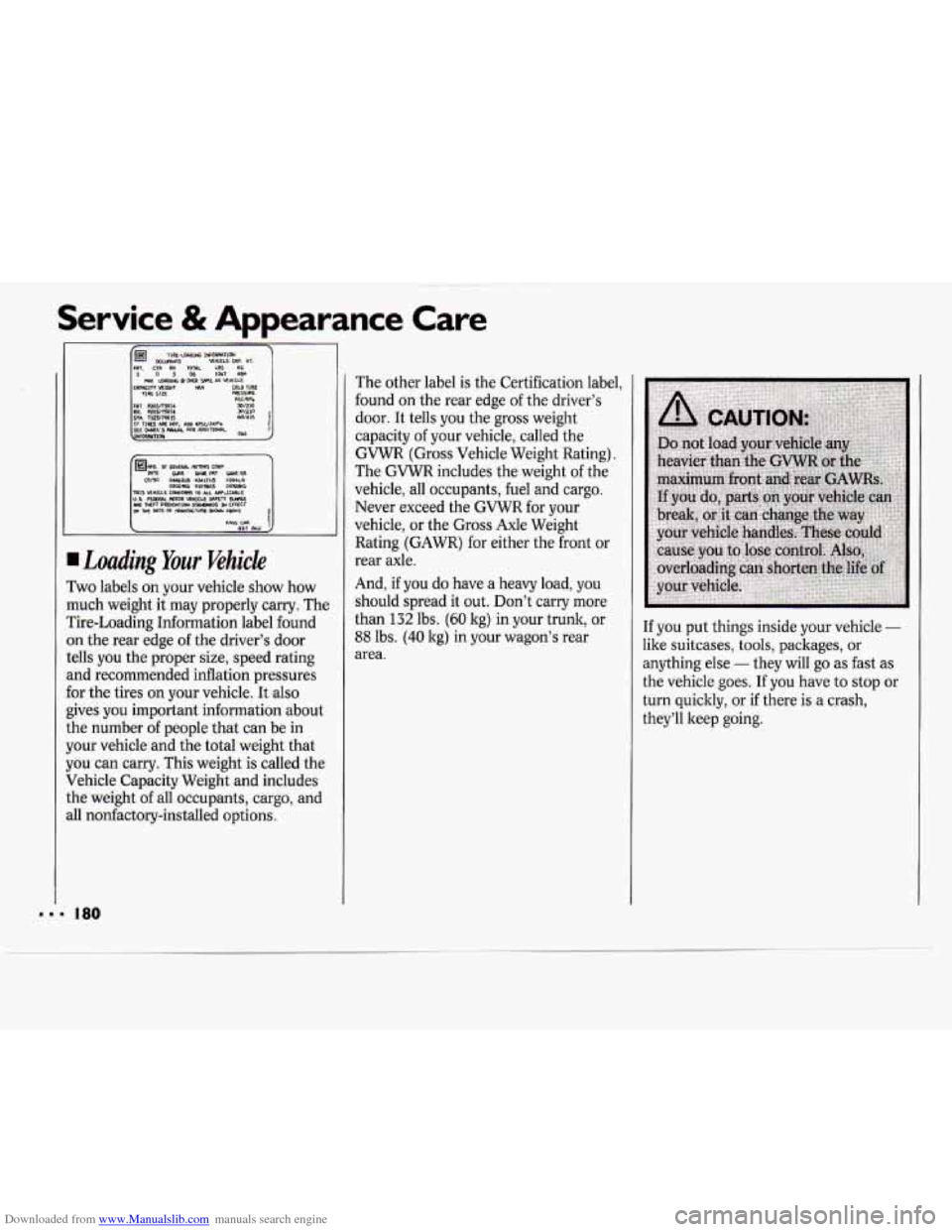
Downloaded from www.Manualslib.com manuals search engine Service & Appearance Care
I Loading Your Vehicle
Two labels on your vehicle show how
nuch weight it may properly carry. The
rire-Loading Information label found
In the rear edge of the driver's door
.ells you the proper size, speed rating
md recommended inflation pressures
or the tires on your vehicle. It also
:ives you important information about
.he number of people that can be in
four vehicle and the total weight that
rou can carry. This weight
is called the
Jehicle Capacity Weight and includes
.he weight
of all occupants, cargo, and
111 nonfactory-installed options. The other label is
the Certification label,
found on the rear edge of the driver's
door. It tells you the gross weight
capacity of your vehicle, called the
GVWR (Gross Vehicle Weight Rating).
The
GVWR includes the weight of the
vehicle, all occupants, fuel and cargo.
Never exceed the GVWR for your
vehicle,
or the Gross Axle Weight
Rating (GAWR) for either the front or
rear axle.
And, if you do have a heavy load, you
should spread it out. Don't carry more
than
132 lbs. (60 kg) in your trunk, or
88 lbs. (40 kg) in your wagon's rear
area. If you put things inside your vehicle -
like suitcases, tools, packages, or
anything else
- they will go as fast as
the vehicle goes. If you have to stop or
turn quicltly, or
if there is a crash,
they'll keep going.
Page 183 of 243
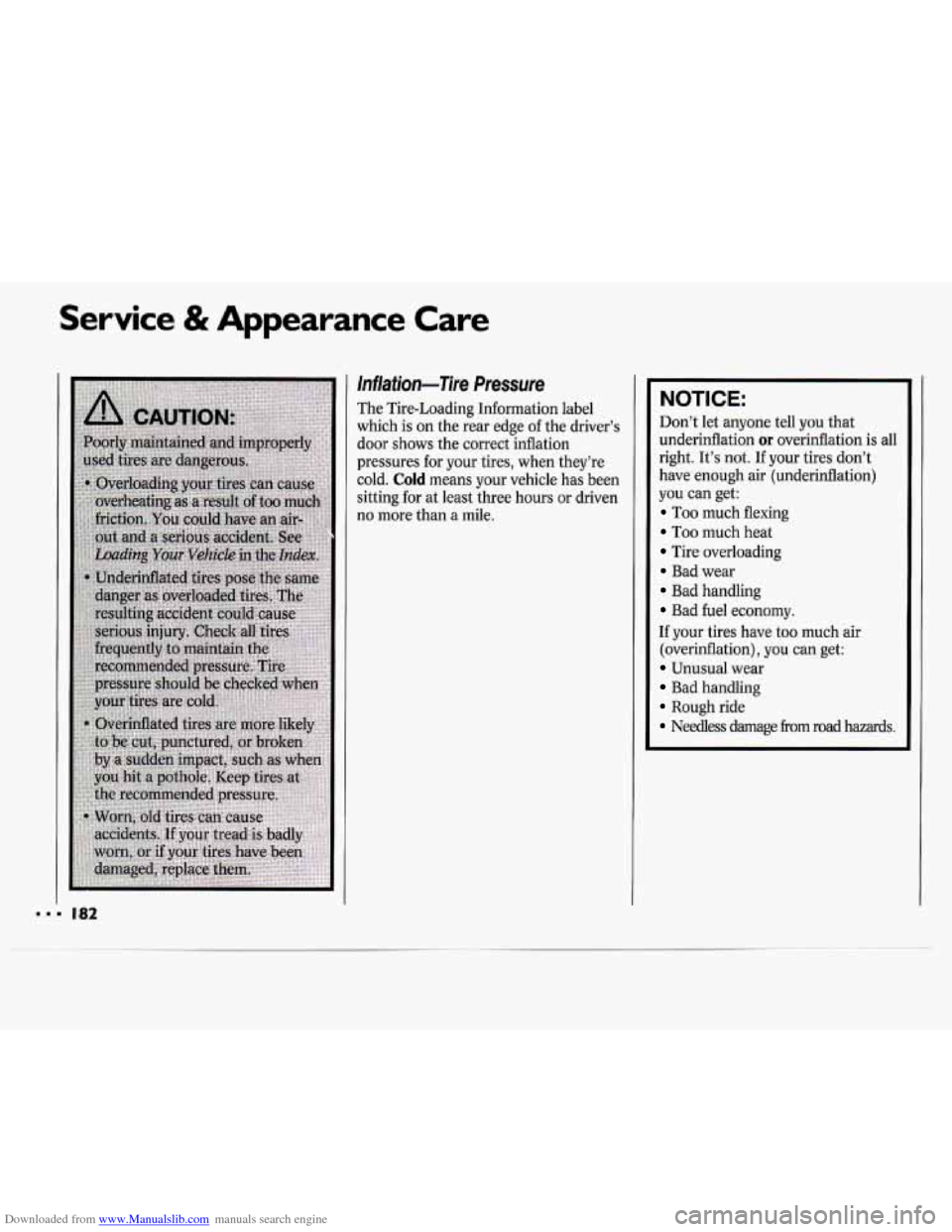
Downloaded from www.Manualslib.com manuals search engine Service & Appearance Care
Inflation-Tire Pressure
The Tire-Loading Information label
which is on the rear edge of the driver’s
door shows the correct inflation
pressures for your tires, when they’re
cold.
Cold means your vehicle has been
sitting for at least three hours or driven
no more than a mile.
NOTICE:
Don’t let anyone tell you that
underinflation
or overinflation is all
right. It’s not. If your tires don’t
have enough air (underinflation)
you can get:
Too much flexing
Too much heat
Tire overloading
Bad wear
Bad handling
Bad fuel economy.
If your tires have
too much air
(overinflation), you can get:
Unusual wear
Bad handling
Rough ride
Needless damage from road hazards.
Page 184 of 243
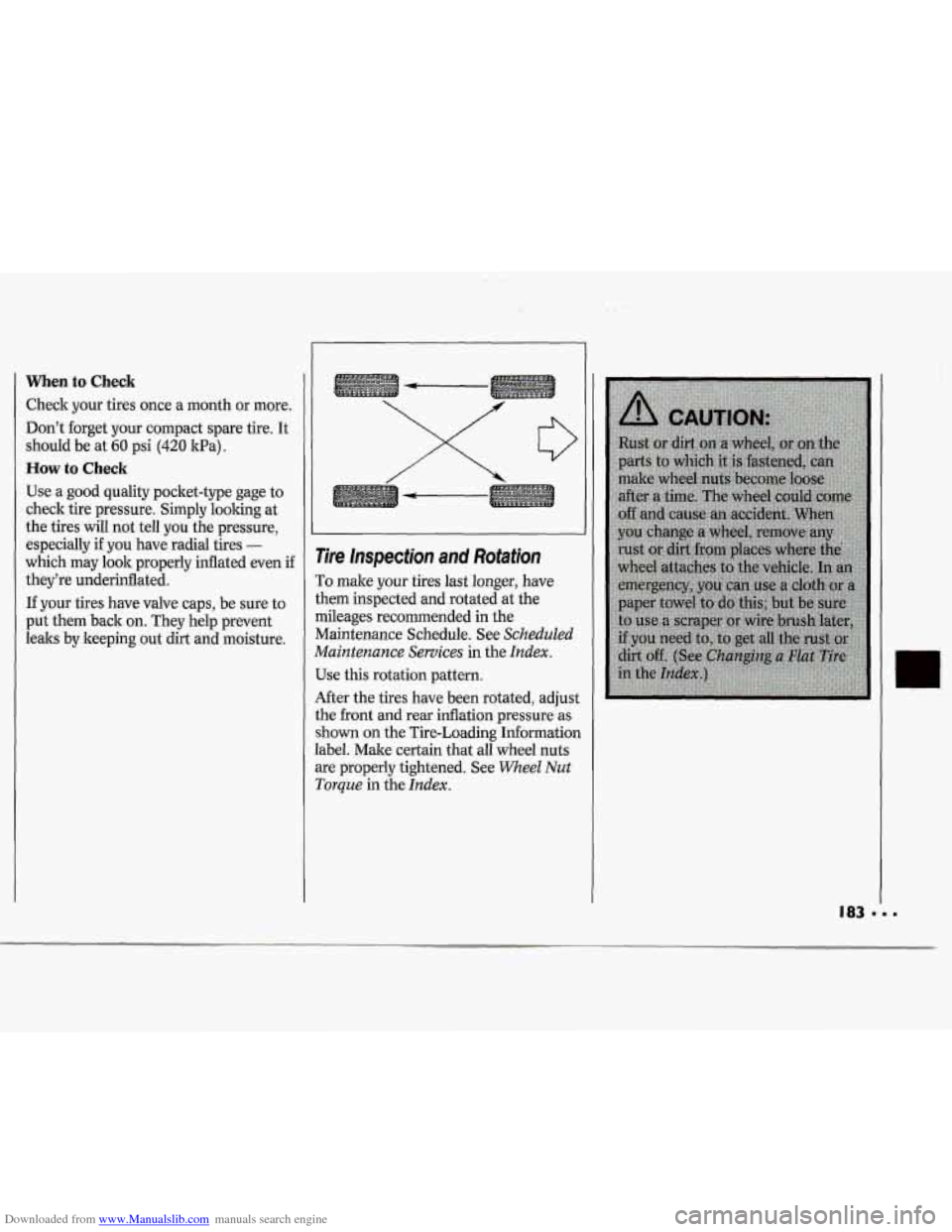
Downloaded from www.Manualslib.com manuals search engine When to Check
Check your tires once a month or more.
Don't forget your compact spare tire. It
should be at
60 psi (420 1tPa).
How to Check
Use a good quality pocket-type gage to
check tire pressure. Simply looking at
the tires
will not tell you the pressure,
especially if you have radial tires
-
which may look properly inflated even if
they're underinflated.
If your tires have valve caps, be sure to
put them back on. They help prevent
leaks by keeping out dirt and moisture.
x
Tire lnspection and Rotation
To make your tires last longer, have
them inspected and rotated at the
mileages recommended in the
Maintenance Schedule. See
Scheduled
Maintenance Services
in the Index.
Use this rotation pattern.
After the tires have been rotated, adjust
the front and rear inflation pressure as
shown on the Tire-Loading Information
label. Make certain that all wheel nuts
are properly tightened. See
Wheel Nut
Torque in the Index.
Page 186 of 243
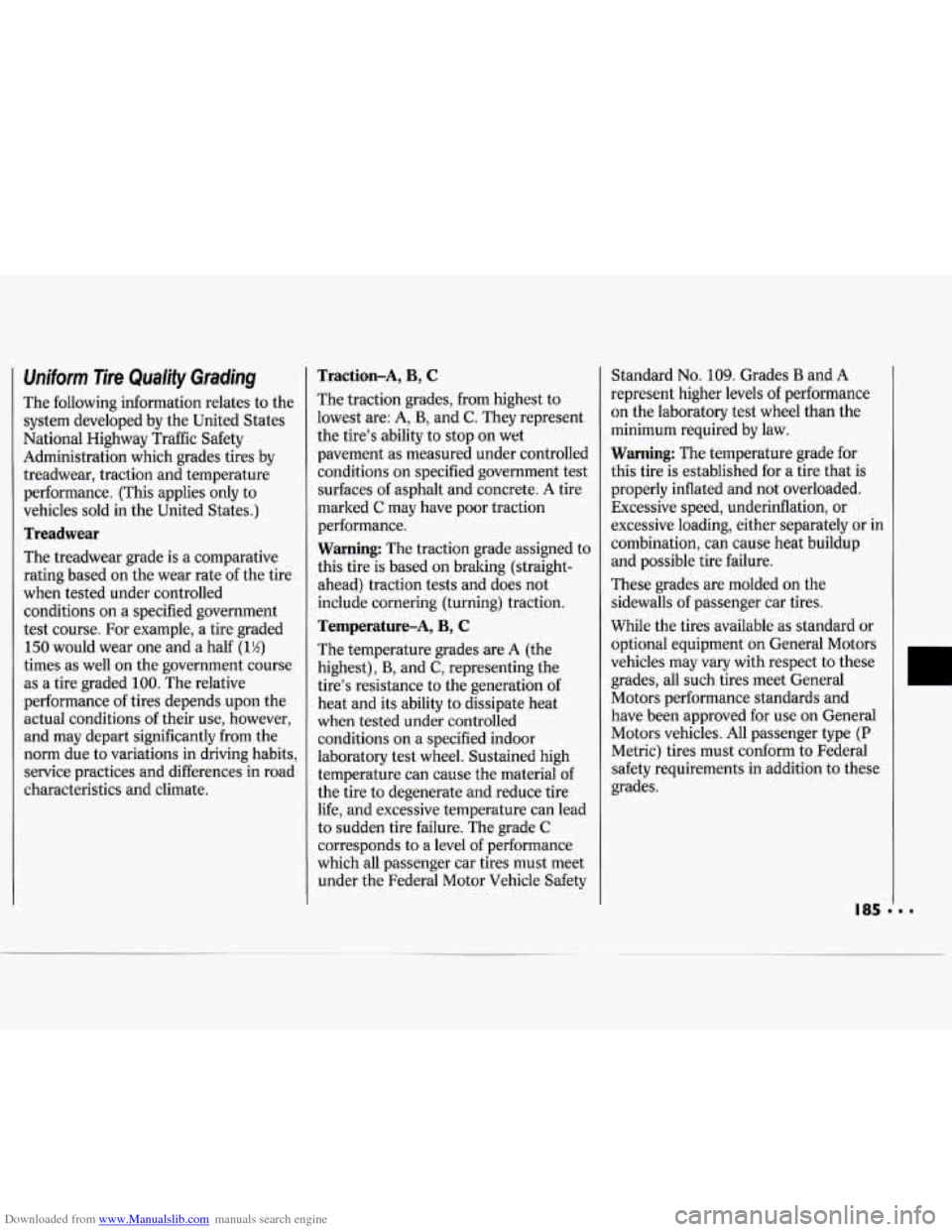
Downloaded from www.Manualslib.com manuals search engine Uniform Tire Qualify Grading
The following information relates to the
system developed by the United States
National Highway Traffic Safety
Administration which grades tires by
treadwear, traction and temperature
performance. (This applies only to
vehicles sold in the United States.)
Treadwear
The treadwear grade is a comparative
rating based on the wear rate
of the tire
when tested under controlled
conditions on a specified government
test course. For example, a tire graded
150 would wear one and a half (1 Yz)
times as well on the government course
as a tire graded
100. The relative
performance of tires depends upon the
actual conditions
of their use, however,
and may depart significantly from the
norm due to variations in driving habits,
service practices and differences in road
characteristics and climate.
Traction-A, B, C
The traction grades, from highest to
lowest are: A,
B, and C. They represent
the tire’s ability to stop on wet
pavement as measured under controlled
conditions on specified government test
surfaces
of asphalt and concrete. A tire
marked
C may have poor traction
performance.
Warning: The traction grade assigned to
this tire
is based on braking (straight-
ahead) traction tests and does not
include cornering (turning) traction.
Temperature-A, B, C
The temperature grades are A (the
highest),
B, and C, representing the
tire’s resistance to the generation
of
heat and its ability to dissipate heat
when tested under controlled conditions on a specified indoor
laboratory test wheel. Sustained high
temperature can cause the material of
the tire to degenerate and reduce tire
life, and excessive temperature can lead
to sudden tire failure. The grade
C
corresponds to a level of performance
which all passenger car tires must meet
under the Federal Motor Vehicle Safety Standard
No.
109. Grades B and A
represent higher levels
of performance
on the laboratory test wheel than the
minimum required by law.
Warning: The temperature grade for
this tire is established for a tire that is
properly inflated and not overloaded.
Excessive speed, underinflation, or
excessive loading, either separately or in
combination, can cause heat buildup
and possible tire failure.
These grades are molded on the
sidewalls of passenger car tires.
While the tires available as standard or
optional equipment
on General Motors
vehicles may vary with respect to these
grades, all such tires meet General
Motors performance standards and
have been approved for use on General
Motors vehicles. All passenger type
(P
Metric) tires must conform to Federal
safety requirements in addition to these
grades.
1
Page 205 of 243
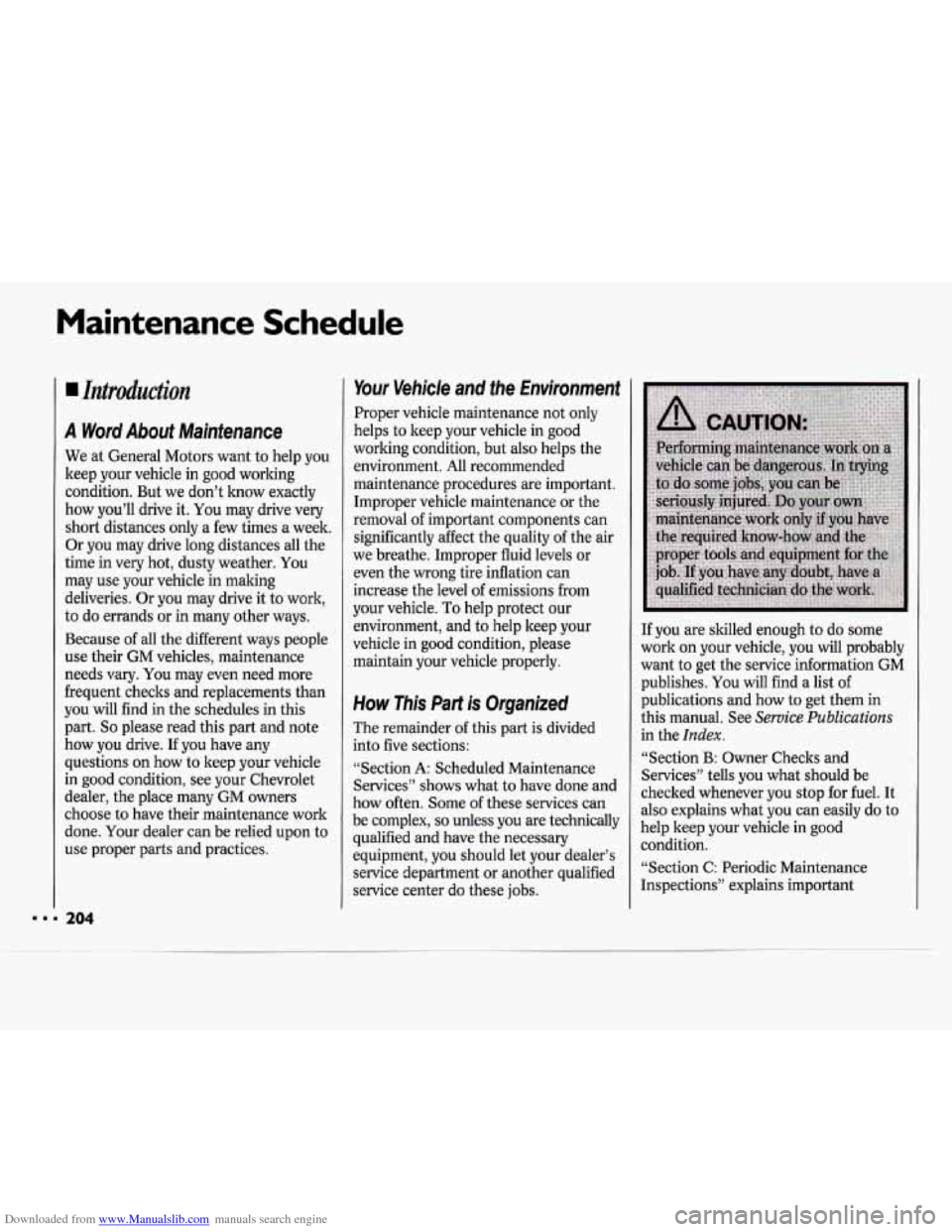
Downloaded from www.Manualslib.com manuals search engine Maintenance Schedule
BB
A Word About Maintenance
We at General Motors want to help you
keep your vehicle in good working
condition. But we don’t know exactly
how you’ll drive it. You may drive very
short distances only a few times a week.
Or you may drive long distances all the
time in very hot, dusty weather. You
may use your vehicle in malting
deliveries. Or you may drive it to work,
to do errands
or in many other ways.
Because of all the different ways people
use their GM vehicles, maintenance
needs vary. You may even need more
frequent checks and replacements than
you will find in the schedules in this
part.
So please read this part and note
how you drive. If you have any
questions on how to keep your vehicle
in good condition, see your Chevrolet
dealer, the place many
GM owners
choose to have their maintenance work
done. Your dealer can be relied upon to
use proper parts and practices.
204
Your Vehicle and the Environment
Proper vehicle maintenance not only
helps to keep your vehicle in good
working condition, but also helps the
environment. All recommended
maintenance procedures are important.
Improper vehicle maintenance or the
removal of important components can
significantly affect the quality of the air
we breathe. Improper fluid levels or
even the wrong tire inflation can
increase the level
of emissions from
your vehicle.
To help protect our
environment, and to help keep your
vehicle in good condition, please
maintain your vehicle properly.
How This Part is Organized
The remainder of this part is divided
into five sections:
“Section A: Scheduled Maintenance
Services” shows what to have done and
how often. Some
of these services can
be complex,
so unless you are technically
qualified and have the necessary
equipment, you should let your dealer’s
service department or another qualified
service center do these jobs. If
you are skilled enough to do some
work on your vehicle, you will probably
want to get the service information GM
publishes. You will find a list of
publications and how
to get them in
this manual. See
Service Publications
in the Index.
“Section B: Owner Checks and
Services” tells you what should be
checked whenever you stop for fuel. It
also explains what you can easily do to
help keep your vehicle in good
condition.
“Section
C: Periodic Maintenance
Inspections” explains important
Page 214 of 243
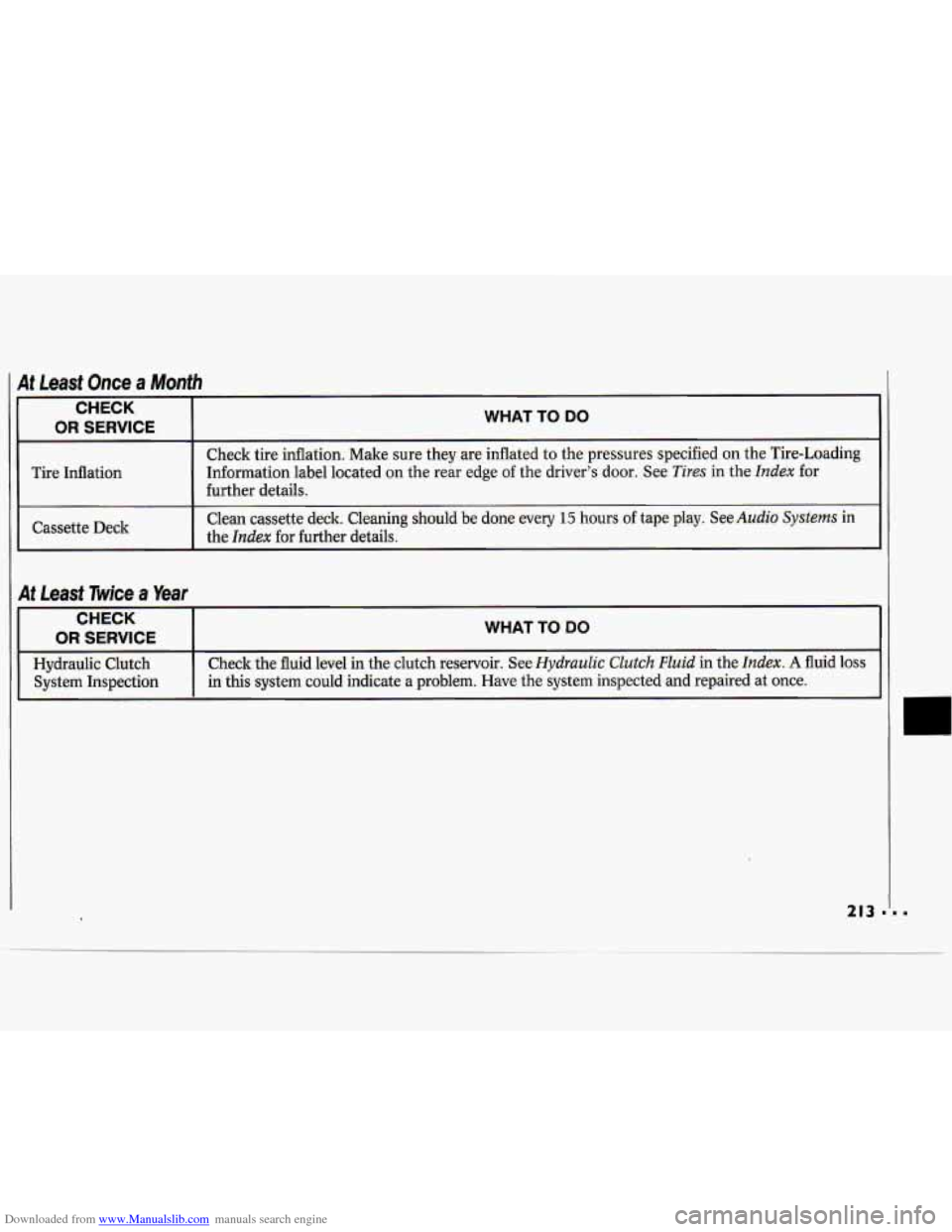
Downloaded from www.Manualslib.com manuals search engine CHECK
OR SERVICE WHAT TO DO
Check tire inflation. Make sure they are inflated to the pressures specified on the Tire-Loading
further details. Clean cassette deck. Cleaning should be done every
15 hours of tape play. See Audio Systems in
the
Index for further details.
Tire Inflation
Information label located on the rear edge of the driver’s door. See
Tires in the Index for
Cassette Deck
At Least Twice a Year
CHECK
OR SERVICE WHAT TO DO
Hydraulic Clutch Check
the fluid level in the clutch reservoir. See Hydraulic CZutch Huid in the Index. A fluid loss
System Inspection in this system could indicate a problem. Have the system inspected and repaired at once.
213 I.
Page 234 of 243
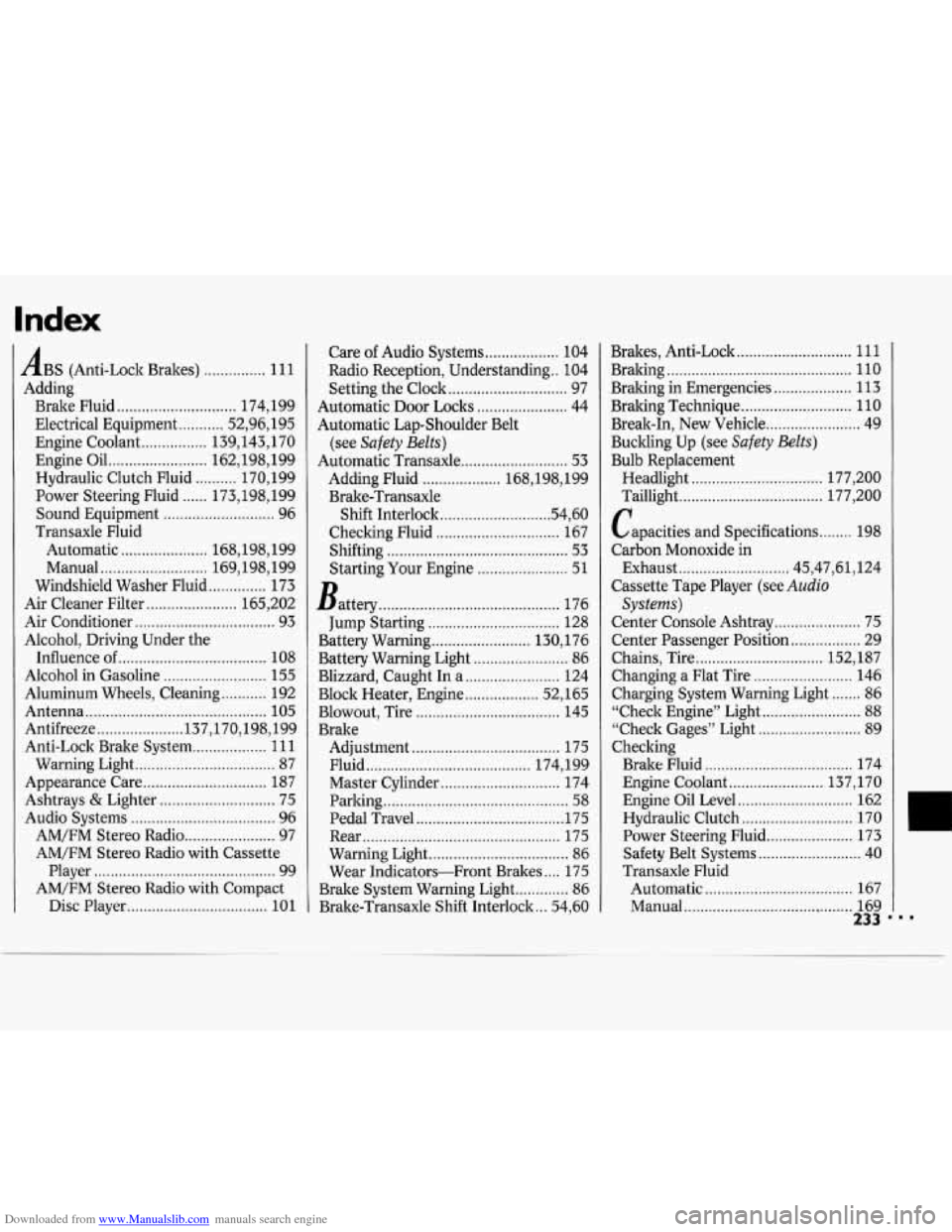
Downloaded from www.Manualslib.com manuals search engine Index
ABS (Anti-Lock Brakes) ............... 11 1
Adding
Brake Fluid
............................. 174. 199
Engine Coolant
................ 139.143. 170
Engine Oil
........................ 162,198, 199
Hydraulic Clutch Fluid
.......... 170, 199
Power Steering Fluid
...... 173,198, 199
Sound Equipment ........................... 96
Transaxle Fluid
Automatic
..................... 168,198, 199
Manual
.......................... 169,198, 199
Windshield Washer Fluid
.............. 173
Air Cleaner Filter
...................... 165, 202
Air Conditioner
.................................. 93
Alcohol. Driving Under the
Influence of
.................................... 108
Alcohol in Gasoline
......................... 155
Antenna ............................................ 105
Antifreeze ..................... 137,170,198, 199
Anti-Lock Brake System
.................. 111
Warning Light .................................. 87
Appearance Care
.............................. 187
Ashtrays & Lighter ............................ 75
Audio Systems
................................... 96
AM/FM Stereo Radio
...................... 97
AM/FM Stereo Radio with Cassette
Player
............................................ 99
AM/FM Stereo Radio with Compact
Disc Player
.................................. 101
Electrical
Equipment
........... 52.96. 195
Aluminum Wheels, Cleaning
........... 192 Care
of Audio
Systems .................. 104
Radio Reception. Understanding
.. 104
Setting the Clock
............................. 97
Automatic Door Loclts
...................... 44
Automatic Lap-Shoulder Belt
(see
Safety Belts)
Automatic Transaxle .......................... 53
Adding Fluid ................... 168.198. 199
Brake-Transaxle Shift Interlock..
........................ .54. 60
Checking Fluid
.............................. 167
Shifting
............................................ 53
Starting Your Engine ...................... 51
Battery
............................................ 176 .
Jump Starting ................................ 128
Battery Warning
........................ 130. 176
Battery Warning Light
....................... 86
Blizzard. Caught In
a ....................... 124
Block Heater. Engine
.................. 52. 165
Blowout. Tire
................................... 145
Brake Adjustment
.................................... 175
Fluid
........................................ 174. 199
Master Cylinder ............................. 174
Parking
............................................. 58
Pedal Travel .................................... 175
Rear
................................................ 175
Warning Light
.................................. 86
Wear Indicators-Front Brakes .... 175
Brake System Warning Light
............. 86
Brake-Transaxle Shift Interlock ... 54. 60 Brakes. Anti-Lock
............................ 111
Bralcing ............................................. 110
Bralcing in Emergencies
................... 113
Braking Technique ........................... 110
Break-In. New Vehicle
....................... 49
Buckling
Up (see Safety Belts)
Bulb Replacement
Headlight
................................ 177, 200
Taillight
................................... 177, 200
Capacities and Specifications
........ 198
Carbon Monoxide in
Exhaust
........................... 45,47,61, 124
Cassette Tape Player (see
Audio
Systems)
Center Console Ashtray ..................... 75
Center Passenger Position
................. 29
Chains, Tire
............................... 152, 187
Changing
a Flat Tire ........................ 146
Charging System Warning Light
....... 86
“Check Engine” Light ........................ 88
“Check Gages” Light ......................... 89
Checking
Brake Fluid
.................................... 174
Engine Coolant
....................... 137, 170
Engine Oil Level
............................ 162
Hydraulic Clutch
........................... 170
Power Steering Fluid
..................... 173
Safety Belt Systems
......................... 40
Transaxle Fluid
Automatic
.................................... 167
Manual
................................ ,. ........ 169
233
Page 236 of 243
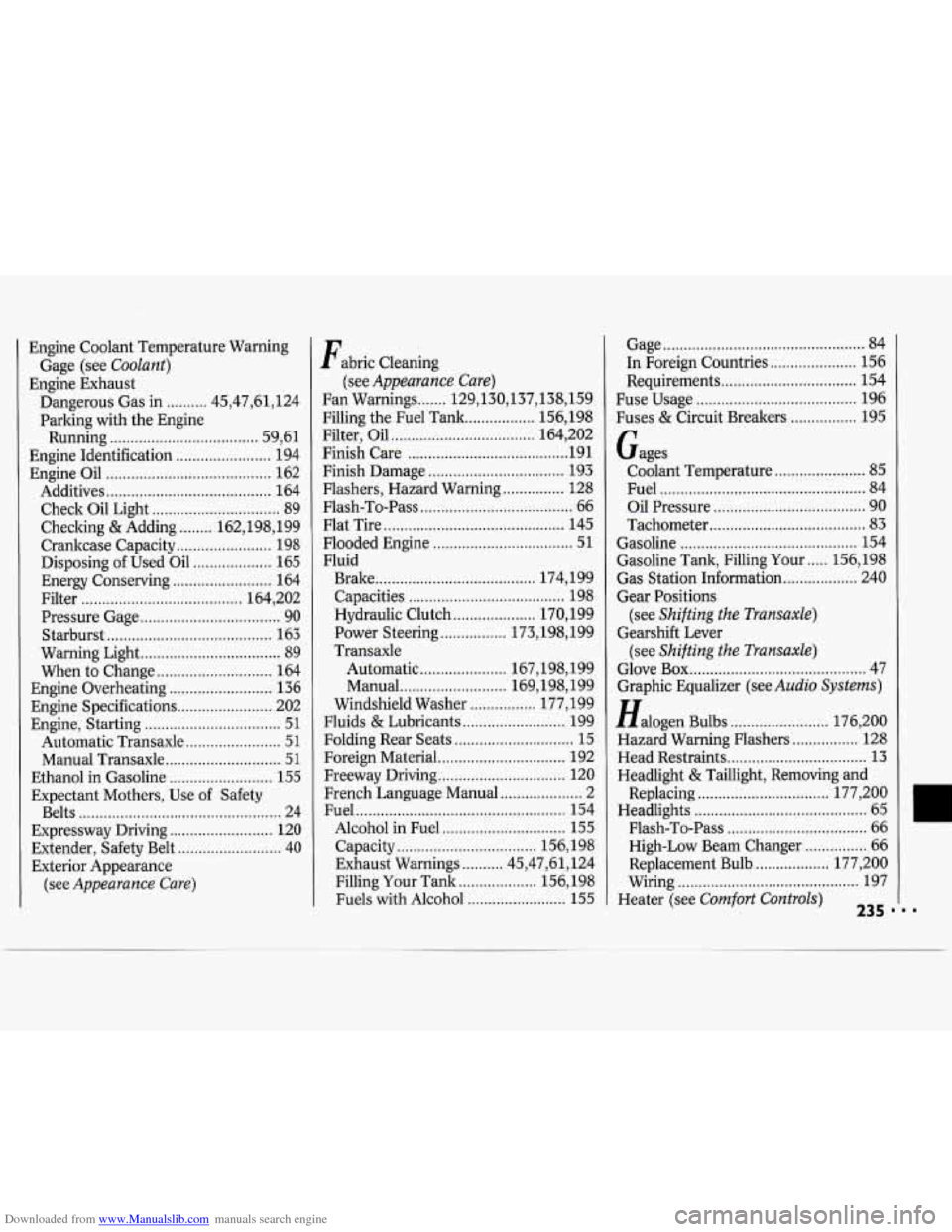
Downloaded from www.Manualslib.com manuals search engine Engine Coolant Temperature Warning
Engine Exhaust Gage (see
Coolant)
Dangerous Gas
in .......... 45.47.61. 124
Parking with the Engine
Running
.................................... 59. 61
Engine Identification
....................... 194
Engine Oil
........................................ 162
Additives
........................................ 164
Check Oil Light
............................... 89
Checking &Adding
........ 162.198. 199
Crankcase Capacity
....................... 198
Disposing of Used Oil
................... 165
Energy Conserving
........................ 164
Filter
....................................... 164. 202
Pressure Gage
.................................. 90
Starburst
........................................ 163
Warning Light
.................................. 89
When to Change
............................ 164
Engine Overheating
......................... 136
Engine Specifications ....................... 202
Engine. Starting
................................. 51
Automatic Transaxle
....................... 51
Manual Transaxle
............................ 51
Ethanol in Gasoline
......................... 155
Expectant Mothers. Use
of Safety
Belts
................................................. 24
Extender. Safety Belt
......................... 40
Exterior Appearance
Expressway Driving
......................... 120
(see Appearance
Care)
Fabric Cleaning
Fan Warnings
....... 129.130.137.138. 159
Filling the Fuel Tank
................. 156. 198
Filter. Oil
................................... 164, 202
Finish Care
....................................... 19 1
Finish Damage ................................. 193
Flashers, Hazard Warning
............... 128
Flash-To-Pass
..................................... 66
Flat Tire
............................................ 145
Flooded Engine
.................................. 51
Fluid Brake
....................................... 174, 199
Capacities
...................................... 198
Hydraulic Clutch
.................... 170. 199
Power Steering
................ 173,198, 199
Transaxle Automatic
..................... 167,198, 199
Manual
.......................... 169,198, 199
Windshield Washer
................ 177, 199
Fluids
& Lubricants ......................... 199
Foreign Material
............................... 192
Freeway Driving
............................... 120
French Language Manual
.................... 2
Fuel
................................................... 154
Alcohol in Fuel
.............................. 155
Capacity
.................................. 156, 198
Exhaust Warnings
.......... 45,47,61, 124
Filling Your Tank
................... 156, 198
Fuels with Alcohol
........................ 155
(see
Appearance
Care)
Folding Rear Seats ............................. 15
Gage ................................................. 84
In Foreign Countries ..................... 156
Requirements
................................. 154
Fuse Usage
....................................... 196
Fuses
& Circuit Breakers ................ 195
Gages Coolant Temperature
...................... 85
Fuel .................................................. 84
Oil Pressure
..................................... 90
Tachometer
...................................... 83
Gasoline ........................................... 154
Gasoline Tank, Filling Your
..... 156, 198
Gas Station Information
.................. 240
Gear Positions
Gearshift Lever
Glove Box
........................................... 47
Graphic Equalizer (see
Audio Systems)
Halogen Bulbs ........................ 176, 200
Head Restraints
.................................. 13
Headlight & Taillight, Removing and
(see
Shifting
the Transaxle)
(see Shifting the Transaxle)
Hazard Warning Flashers ................ 128
Replacing
................................ 177, 200
Headlights
.......................................... 65
Flash-To-Pass
.................................. 66
High-Low Beam Changer
............... 66
Replacement Bulb
.................. 177, 200
Wiring
............................................ 197
Heater (see
Comfort Controls) 235 1 . .